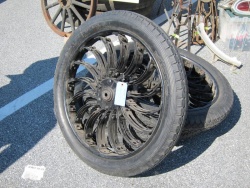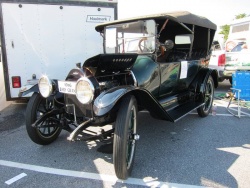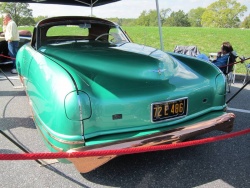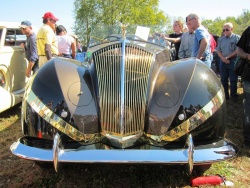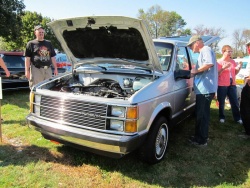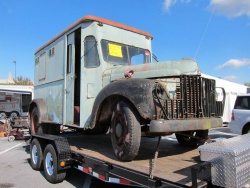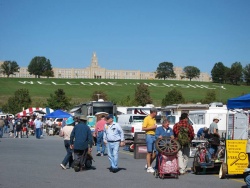 The event is held on the grounds at Hersheypark. Click image to enlarge |
Article and photos by Jil McIntosh
Photo Gallery:
Cars sweeter than candy in Hershey
Hershey, Pennsylvania – I’m generally no fan of Fall, but for one week each October, the end of summer is no longer a hardship. That’s when I pack a vehicle with spouse, friend, luggage and a wagon, and point everything south to a town that’s both famous for chocolate, and what’s believed to be the world’s largest antique automotive flea market. It’s properly the Antique Automobile Club of America (AACA) Fall Meet, but those of us into vintage tin just know it as “Hershey.”
While that name conjures up visions of candy for most, car fans realize it as some ten thousand vendor spots, a massive car corral, and a Saturday show that draws everything from Fords and Chevrolets to such long-forgotten marques as Marmon, Chase, Red Bug and DeDion Bouton – and all of them, no matter how old or how valuable, have to be driven up an entry road to get inside, past long lines of spectators for whom it might be the only chance ever to hear one run.
The trip is also a vehicle test, and it requires the type of vehicle that I normally wouldn’t buy for a personal car. With only two of us, I don’t have the need for people and cargo space that’s the norm for many Canadians with families. I often take a minivan or SUV, but this time I decided to try something different: a 2010 Ford Transit Connect.
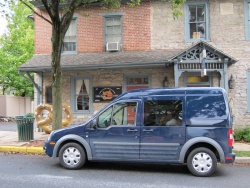 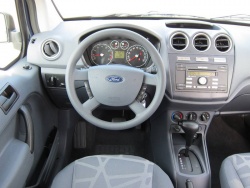 2010 Ford Transit Connect. Click image to enlarge |
Already popular in Europe – it’s built in Turkey – the Transit Connect is most commonly sold as a commercial panel van here. It’s also available in the configuration I took, with a second-row bench seat and windows in its sliding doors. (In reality, that’s how they all arrive in North America right now, due to an obscure Turkish tax; Ford then removes the rear seat and replaces the rear windows with metal panels.) After spending some time with one, I’m hooked on its versatility. I could very easily see buying one of these for a personal vehicle, in place of a minivan or crossover.
The trip traditionally begins at “o-dark-thirty,” as my husband puts it, and so I pointed the Transit Connect’s sloping snout from my Ontario home toward the U.S. border well before the crack of dawn. The TC, as we dubbed it, really isn’t intended to be a highway hauler; rather, it’s an urban work vehicle, perfect for small-item delivery or trades people. Even so, it worked out quite well on the trip. It uses a 2.0-litre gasoline engine (wouldn’t it be marvelous to get a diesel!) that makes 136 horsepower and 128 lb-ft of torque, mated to a four-speed automatic, and it’s front-wheel drive. Fortunately for my right foot, cruise control is a standard feature. Other niceties included with all models are a/c, a CD player with auxiliary input, keyless entry, tilt and telescopic steering wheel, variable intermittent wipers and, on the passenger wagon, electronic stability control. Rear-seat access is through the two sliding doors, and the double rear doors can be opened 90 degrees or, at the touch of a button, out to 180 degrees. The rear seat also folds and tumbles forward if more cargo space is needed, although we didn’t come close to filling it. Front and front seat-side airbags are standard, and the brakes also work very well – as I discovered when a driver going the wrong way on the highway made a U-turn in front of me. Keeps you on your toes, driving does.
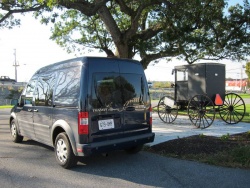 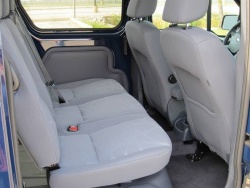 2010 Ford Transit Connect. Click image to enlarge |
The TC runs on 87-octane fuel, although unfortunately Ford’s brilliant Easy Fuel capless system isn’t included. It’s officially rated at 9.5 L/100 km (30 mpg Imp) on the highway and 7.9 (36) in the city. On our trip, which was primarily highway driving around the 112 km/h permitted on the U.S. interstate, and with some stop-and-go in small towns, I averaged 10.5 (27). And while the seats won’t find their way into a Lincoln anytime soon, they weren’t nearly as uncomfortable as I would have expected after a ten-hour driving day. My TC started ticking the cash register at $28,299 and had a couple of options including a reverse sensing system and a block heater. Before freight, taxes and the stewardship fee on its tires, it finished up at $28,629.
In fact, my complaints about the truck were minor, and most of them aimed at better convenience. The cruise control buttons on the steering wheel should be illuminated, as they’re hard to find in the dark; the buttons on the key fob need a touch of white paint, as it’s equally hard to see which of the black-on-black icons is the right one; and for an urban delivery vehicle, the turning circle seems rather wide.
Our first stop is always the town of Lititz, nestled in the heart of Pennsylvania Dutch country, for pretzels and candy – the 145-year-old Wilbur Chocolate makes better treats than Hershey, to my taste – and then to Lancaster, where it’s easier to find a hotel room and there are a couple of favourite restaurants. Each morning, the TC faithfully took us the 30-minute trip to the show, held on the grounds of the Hersheypark amusement centre. The swap meet used to be held entirely on grass, which would instantly turn into the famous sticky-clay “Hershey Mud” whenever it rained, which was often. Now, it’s all entirely on asphalt, but this year, Mother Nature took pity on us and sent sunshine and warm temperatures.
A flea market may seem seriously dated in a world of eBay and other online buy-and-sell sites, but there’s still something about seeing, touching and discovering that you can’t do through a computer screen. The really rare stuff that I saw 15 years ago here seldom makes an appearance anymore; it is smarter, after all, to type in your request for a valve spring for a 1914 Fisher than it is to wander several acres in the hope of spotting one on a vendor’s table. But it’s likely there will always be a place for Hershey and other events like it. Some parts are too big or fragile to ship, some parts are too obscure to identify (vendors put these out in the hopes someone might identify them), and there’s always the question of condition. One man’s good is another man’s garbage, and it’s common to find someone who bought an old part online and discovered it wasn’t in quite the shape the seller claimed it to be.
Of course, the antique-car community has an entirely different outlook than with those who dabble in newer cars. Our little TC happily gobbled up three 1930s Chevrolet fenders for a friend back home. Someone not into old cars would have wondered why these rusty pieces hadn’t gone directly to the scrap yard, but they were actually quite solid, all the hard-to-find mounting brackets were on them, and minor dents and a couple of rust holes could be readily fixed. When you’re looking for something that was made some 80 years ago, you expect that a little elbow grease will be involved.
For as much fun as the three-day flea market is, the big day is actually Saturday, when club members bring their vehicles out for showing and judging. Once the cars and trucks make their way down the entry road and into the show area, they’re out for everyone to see and photograph. In many cases, these are cars that most people will only ever see in museums, if they see them at all. It was tough to get close to a custom-bodied 1939 Rolls-Royce that was the hit of the show, with its wildly futuristic streamlined body, gold accents and hidden headlights. But believe it or not, there was also a crowd around a vehicle no one expected – a 1984 Plymouth Voyager. The show has a 25-year “sliding scale,” so that each year a fresh number of vehicles can enter, and time marches on. It sure made me feel old to see an “antique” car that I remembered first coming into the showroom when I worked at a dealership way back when, but on the other hand, there’s a fascination in seeing a vehicle like that in perfect condition. I wouldn’t want to see a whole field of minivans, or cars like the Ford Fairmont and AMC Pacer that were also represented, but a couple of them salted here and there make for an interesting event.
The show also draws vehicles that many people simply worked to death and seldom bothered saving: antique school buses, dump trucks, garbage trucks, tractor-trailers, tow trucks and other commercial vehicles are always a popular draw. These big vehicles are difficult to store, drive and restore, and it’s always a pleasure to see them in all their original glory. And while the show doesn’t permit modified vehicles such as street rods, there is a special exemption for historic modified vehicles, providing they’re unchanged from when they were built back in the 1950s. This always draws a few race cars and vintage vehicles from the early days of the salt flats.
With our little trucklet heavily loaded with car parts and the various memorabilia I picked up, Hershey was over for another year, and it was time to make the long trek home. As it did on the way down, the TC performed as expected. And who knows? Maybe in 2035, one of these little trucks might well be not in the parking lot, but in the show field, letting people know what driving was like in the “good old days.”







 Follow Autos on Twitter
Follow Autos on Twitter